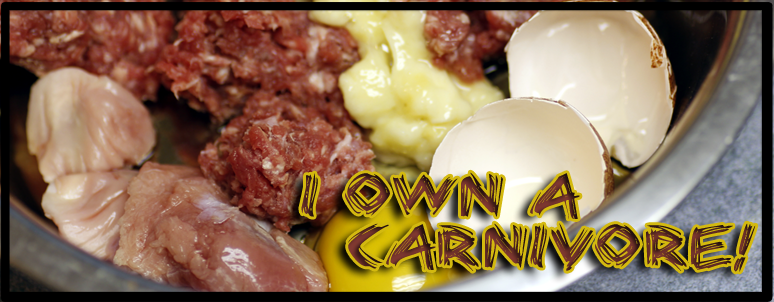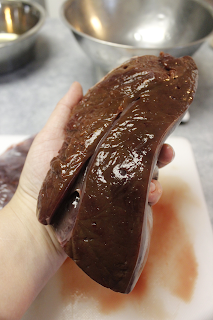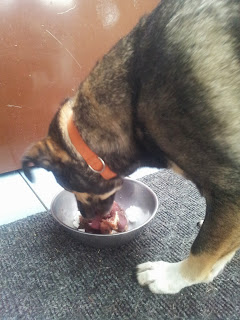I haven't written a "getting started" post yet because I Own a Carnivore! has been about my journey, not necessarily guiding others. But if you're here out of curiosity and are considering starting your carnivores on a "biologically appropriate diet" then why not help point you in the right direction?
What Does a "Biologically Appropriate Diet" Mean?
“Biologically appropriate” foods are those for which we are physiologically adapted. A diet that is naturally appropriate for the species and will fuel them to run optimally.
I first got into feeding raw in 2002 with my Australian Shepherd cross. Back then there wasn't a lot of information on raw feeding, and back then it was called the "BARF" diet (Bones And Raw Food). More recently it is called "Biologically Appropriate Raw Food", but can often still be found with the same BARF acronym.
What is "Prey Model"?
"Prey Model" is a relatively new, but fast growing concept that dogs are carnivores. The Prey Model diet is intended to feed dogs appropriately using raw meat bones and organs (no fruits, veggies or grains).
The concern with feeding a PM diet is that the dog won't get all the nutrients required from such a limited food source. This is untrue. A dog can not only function well but
thrive on a PM diet. As long as you are feeding a large variety of meat, bones and organs (organs being very important as they're jam packed with vitamins and minerals essential to the body) a dog can thrive without other food sources.
If you know that finding a variety of BMO (Bone Meat and Organ) may be a problem for you, the Prey Model diet may not be best for you for this reason. Supplementing with veggies, fruits or herbs can fill in the nutritional gaps if you cannot provide a full range of BMO.
How Much & What Do I Feed?
This is always a common question. Most people are use to reading the label on a bag and it tells you 'two scoops' if Fido is 60lbs and up, etc. so the idea of having to regulate your dogs food on your own can be a bit daunting. It was for me. I was quite worried I'd be under feeding or over feeding my dogs when I first started.
Part of this is math and part of it is just experience and time. The recommended amount when you first start is 2-3% of your dogs ideal body weight. If your dog is under or overweight to begin with you want to make sure you're feeding for his
ideal weight, not his current weight. If your dog is more active you may choose to feed more than 2-3% of his ideal body weight.
Other factors to consider is whether your dog is a puppy, senior, nursing or pregnant mother or performance dog. Each of these factors may require different amounts and different nutrition. This is something that would take far too long to explain here, so if your dog falls under one of these categories you'll need to do some more research to get you started on how much to feed, sorry!
Raw4Dogs has an excellent
Raw Feeding Calculator. This is what helped me get started feeding my dogs, and I didn't have any problems with it.
What you feed your dog may depend on the type of diet you choose to feed. About 50% should be raw meaty bones, 35% muscle meats and 15% organ meats.
Raw Meaty Bones: turkey necks and backs; beef ribs and tails; lamb goat and venison necks and ribs; chicken or duck backs and necks. If you're feeding bonier meals such as ribs and backs feed closer to 40% RMB than 50%. RMB's are meaty bones that your dog can completely consume.
Muscle Meats: heart is a common muscle meat that can be fed often but should not be the main muscle meat. Gizzards are also muscle meats, not organs.
Raw Eggs With Shell (count as a meat meal when buying organic or farm fresh): Raw eggs with shell are a perfect ratio of calcium to phosphorus as well.
These should be fed about 2 or more times a week. Raw egg whiles to pose
a threat and that is that they contain a protien that binds with biotin
and can cause a biotin deficiency. To combat this, make sure you feed
the whole egg. Egg yolks are where most of the nutrients comes from and
are an excellent source of magnesium, calcium, iron, folate and vitamins
A, E and B6. Omega-3 or free-range eggs are best. Commercial eggs are
most likely sprayed with wax and other chemicals to improve their
appearance (but toxicities don't matter because humans don't usually eat
the shell!). Shells can cause tears if eaten whole. For safety reasons I prefer to feed the shells in a powder form. See
How To Make Calcium Powder From Eggs for more information!
Raw Offal (organ meats): Organs should be fed in a variety of
meat sources for 1-2 meals a week or 10-15% of your dogs diet. Some dogs
do not tolerate offal well, so it may be best to divide it up and feed
it a little each day to avoid loose stools.
Recreational Bones: Recreational Bones are those your dog can't actually consume, but rather can chew the meat off and suck the marrow out of. Recreational bones are one of those things that can be a hot button topic in the raw feeding world, as they pose a higher risk to your dog, especially when it comes to breaking teeth. Feeding recreational bones help strengthen your dogs jaw and neck muscles, cleans teeth, and provides the very nutritious bone marrow. It also keeps your dog busy! I personally do feed recreational bones, but this is a decision you will have to weigh the pros and cons for yourself.
Fruits & Vegetables: If you're not feeding a Prey Model diet you may wish to incorporate fruits and veggies into your dogs diet to fill in any nutritional gaps. Dogs will not get the entire nutritional value if fed raw and whole. Veggies must first be run through a juicer or food processor or can be lightly steamed to break down the cell wall that dogs cannot properly break down themselves. Dark green leafy vegetables are high in vitamin B. Ripened fruits are more easily digested by dogs and are also packed with vitamins. Nutritional herbs can also be fed, such as dandelion leaf, nettle, spirulina and alfalfa which are all high in vitamins and minerals.
Supplements and Power Foods: Raw fish (preferably whole) can be fed for one or two meals per week. Fish oil can also be supplemented. Grain-fed animals lack Omega-3 fatty acids, so if you're feeding mostly meats from animals that are not grass-fed you can use fish oil as an Omega-3 supplement. Flax seed oil can also be a good Omega-3 supplement but is plant based and some dogs do not do well on it (or you may choose to feed a Prey Model diet, in which case you'd want to use fish oils instead). If you can't or don't feed Flax seed oil and cannot get your hands on fish or the mercury and toxins are a concern in fish, you can feed Organic Butter or Omega-3 eggs. Cod Liver Oil is known as one of the "super foods" or "power foods" and the benefits of this fishy supplement seem endless. Raw green tripe is also an amazing power food that should be fed two or more meals per week if you can. Not the bleached white stuff you'll find for human consumption, it has little to no nutritional value. Raw green tripe (it's very stinky, to be warned!) is a perfect balance of calcium to phosphorus (1:1), is rich in digestive enzymes and Lactobacillus Acidophilus, vitamin B, and contains essential fatty acids; Linoleic and Limolenic in the proper ratio. Tripe from grass-fed animals is preferred.
Balance Over Time
"Balance Over Time" is something you'll hear a lot in the raw feeding world. Too many people fret about whether or not their dog is getting a nutritionally balanced diet when being fed a non-commercial diet. It means you shouldn't worry about whether each meal is perfectly balanced, this will make your job of feeding your dog a lot harder than it needs to be! Instead, keep notes (mental or not, I have an entire notebook I scribble in) of what you feed your dogs and over time it should balance out.
Don't spend too much time worrying about balance. To help ease your mind, think of it this way; do you make sure
your meals are balanced? You probably don't spend a lot of time and effort into balancing your meals, as long as the majority of what you're eating is from most of the food groups, you're probably satisfied at that! It's no different from feeding your dog; in the wild they wouldn't be coming up with meal plans to make sure it's all nutritionally balanced so why should you?
There are a few ratios you should aim for. Calcium and phosphorus ratio should be 1:1. This is your meats and bones. Meats are high in phosphorus and bones are high in calcium. Whole prey such as fish, eggs and tripe have a balanced ratio.
Organ meats should be 10 - 15% of your dogs diet. Liver should be fed at least once a week (or split into smaller pieces with each meal throughout the week. Liver is also responsible for filtering toxins in the body, so an organic source should be used for it. If you can get your hands on a variety of other organ meats (lungs, kidneys, etc.) then make sure you do! The more the better!
As gross as they are, some of the more gross parts of an animal are the more nutritious. Chicken feet, beef trachea, tails, lung, kidney, testicles and pizzles (beef penis) are all commonly fed in raw food diets. Beef trachea, trim, chicken and turkey feet are loaded in natural chondroitin and glucosamine, which help to build healthy joints (excellent for senior dogs!).
Safety Rules for Feeding Raw:
Never feed
cooked bones to your dog. Cooked bones become brittle and splinter easily. They can cause ruptures and blockages in the stomach and intestine and cause serious damage that may result in a very pricey vet bill or even death!
It's best if you supervise your dog during meal time to be better safe than sorry. Even raw, uncooked bones can cause blockages, splinter or break teeth. This is a risk you just have to become comfortable with, and eventually will. 10, 000 dogs were killed by contaminated kibble in 2007, and that's just from one contaminated bunch. Food recalls and contamination have been happening in the pet food industry for years, and haven't stopped since 2007. It's far riskier and your pet is worse off feeding even a high quality kibble vs. feeding a raw, home prepared diet.
Salmonella and other bacterial risks are a factor to consider when feeding your dogs. An argument is often that dogs mouths are cleaner than humans, and this is true; your dog does contain more digestive enzymes in his saliva than you do and thus it is a cleaner environment than your mouth. This odes not, however, mean those threats still can't be lingering in your dogs mouth after a raw meal. Your dog licks your face, you now have that bacteria on you and none of the defenses against it that your dog has (or not as good!). The solution is proper hygiene; wash all surfaces and devices before and after you prepare your dogs meals. Wash your hands often (I probably wash my hands at least 5 times while preparing my dogs food). The space in which your dog eats is important too; it should be an easy to clean surface! The dogs often clean up every tiny scrap left behind, but doing a good cleaning afterwards would help ease your mind if bacteria is a concern for you. If you have kids crawling about the floor you may want to even consider feeding your dog in his crate (children shouldn't be allowed to bother the dog while he's eating anyway!).
When it comes to safety and feeding your dog; just use your common sense!
Prepare Your Kitchen!
You will need enough counter space near your kitchen sink. Meats, especially organs, can cause a real bloody mess if you're not prepared! Clean, spacious counters are best to work on. Make sure you have a large cutting board and sharp knives to work with. A food processor or blender can come in handy if you make your own supplements or choose to feed vegetables. A scale that measures in oz:lbs is necessary for measuring your dogs food.
Do Your Homework!
If you're still uneasy about the idea of feeding raw, keep researching. The worst thing you can do is dive in unprepared. The more you learn, and the more you do it, the more comfortable you will feel with feeding raw over time.
Resources:
Dogs Naturally Magazine - Raw Food Primer
























